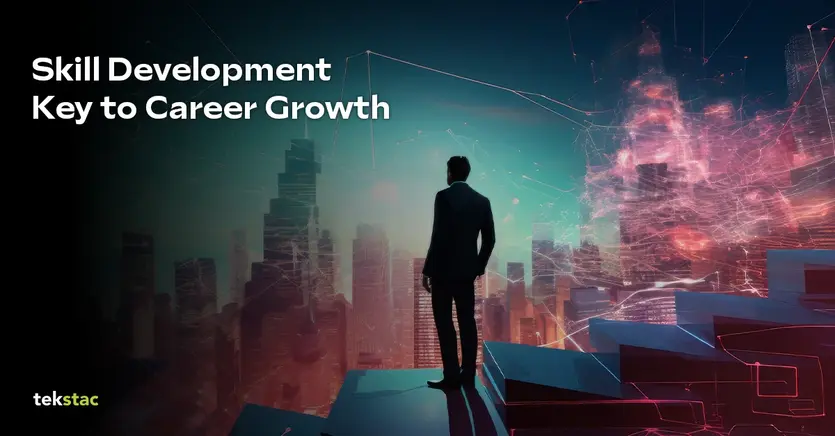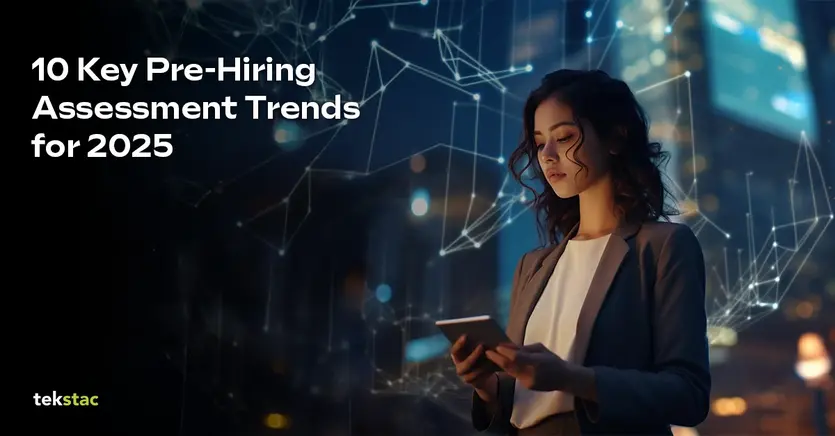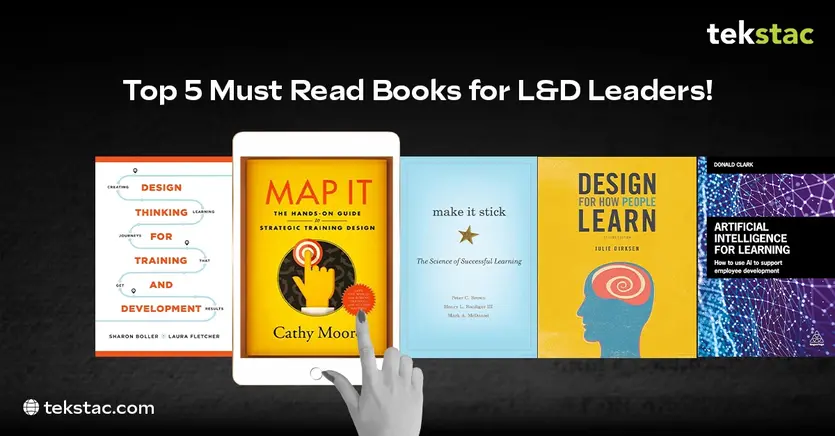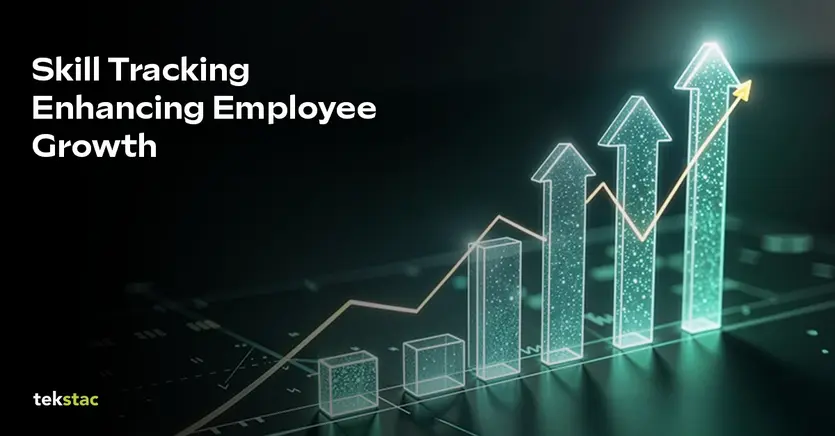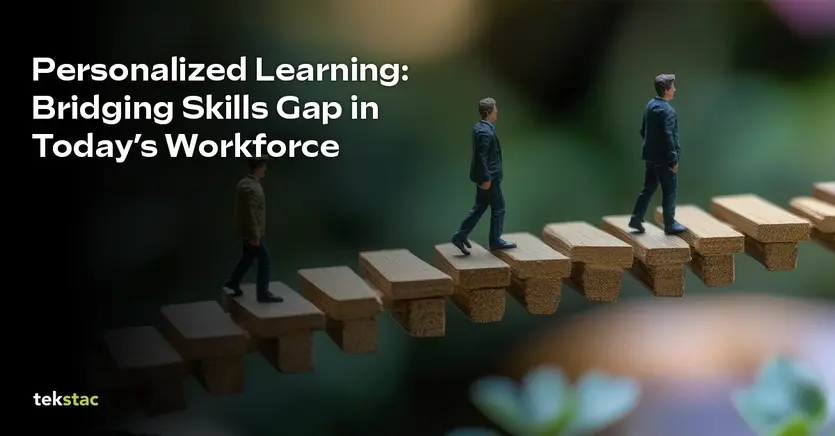Boosting Employee Growth Through Role-Based Training Post-Onboarding
Role-based training is no longer a matter of choice for organizations that are aiming to succeed—it’s a cornerstone of growth and efficiency. This approach equips employees with the skills they need to thrive in their specific roles, ensuring they can make meaningful contributions from the very start. When employees’ abilities align with organizational goals, the result is a team that’s not only productive but also genuinely engaged and motivated.
Why Role-Based Training is Essential for Employee Success
In today’s high-pressure business environment, generic onboarding programs often fall short. They may provide an overview of company policies and values, but they rarely prepare employees for the actual demands of their roles. Imagine hiring a data analyst who learns about company protocols during onboarding but is left clueless when faced with tools needed for that particular role. Without role-specific training, your team members can feel unsupported and overwhelmed, which can quickly lead to lower productivity and frustration.
How Role-Based Training Drives Employee Success Post-Onboarding
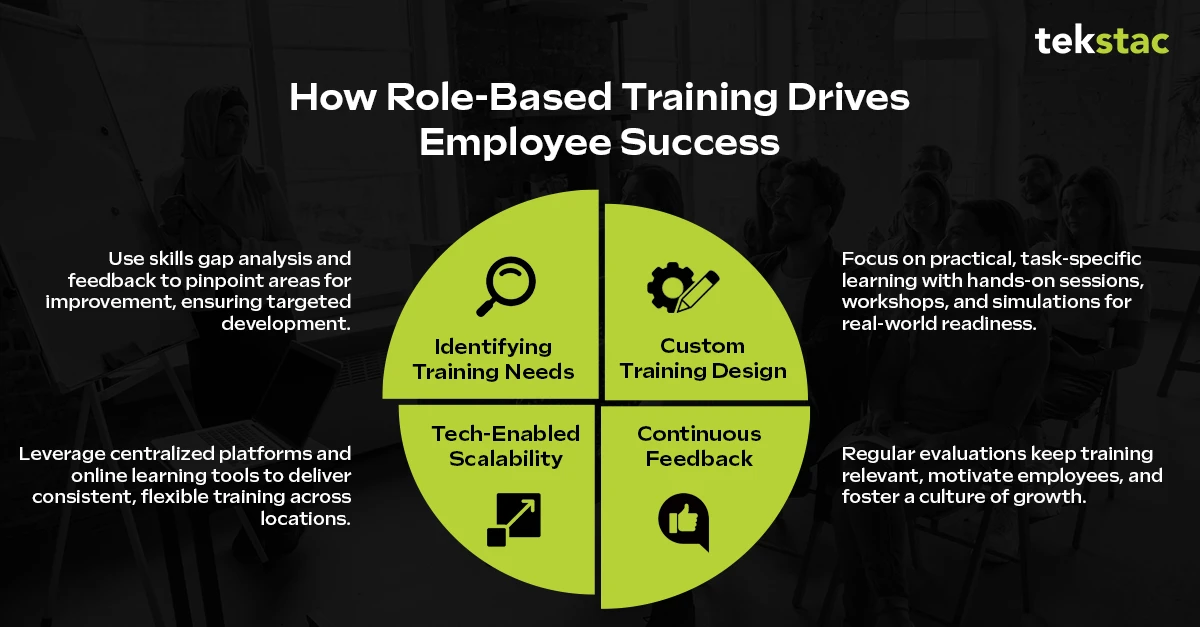
1. Identifying Training Needs
Every effective training program begins with a simple question: what do your employees need to succeed? Understanding these needs is the foundation for building role-based training that delivers real results.
By using tools like skills gap analysis, performance reviews, and feedback sessions, organizations can uncover the exact areas where their workforce needs support.
It could be that your technical team is struggling with a new cloud computing platform, or maybe compliance regulations are changing faster than your employees can keep up.
Without targeted training, these gaps can slow down productivity and lead to costly mistakes. Skills gap analysis provides clarity, showing exactly where development is needed.
Advanced platforms with built-in analytics make the process even smoother, giving you real-time data to craft precise upskilling programs.
Many industries, such as healthcare, will undoubtedly feel the absence of this if they miss out.
2. Designing Custom Role-Based Training Programs
Once you know what your employees need, the next step is to create training that actually helps them succeed. The best way to do this is by keeping it practical and focused on tasks they’ll face every day.
With role-based training, companies can address challenges while building confident, capable teams.
A data analytics team practicing financial modeling through hands-on sessions instead of just sitting through lectures. They’d gain real experience, making them better prepared to handle complex projects.
In another scenario, employees dealing with machine errors could benefit from virtual simulations. This model empowers them to practice safely without worrying about real-world mistakes, helping them build the skills they need to perform better on the job.
People learn best when they can put their skills into action. That’s why role-based training is so much more effective when it includes hands-on learning. Whether it’s through workshops, real-world problem-solving, or virtual labs, these methods help employees build confidence and apply their knowledge in practical ways.
Employees learning risk assessment can benefit from simulations that mimic real-life scenarios.
These practical exercises help them practice decision-making in a controlled environment. The more they experience realistic challenges during training, the fewer mistakes they’ll make when it counts.
3. Using Technology for Scalable Training
Training employees across different locations doesn’t have to be complicated. Centralized skilling platforms bring everything together in one place, so every team member gets the same quality training, no matter where they work.
In industries with high-level tech involvement, where tools and processes change quickly, preparing employees early—like teaching them AI skills or data analysis—can make a big difference. Prepared teams handle change with ease, reducing stress and avoiding disruptions.
Online cloud-based learning platforms add even more value. Employees can learn at their own pace, using short and easy-to-digest courses. This keeps them interested and makes learning less overwhelming.
4. Continuous Evaluation and Feedback
Feedback isn’t just about improving training—it’s a way to show employees that their voices matter. When people feel heard, they stay motivated and connected to their work. Even something as simple as asking for their thoughts can lift their spirits and make them more likely to stick around. Ignoring feedback, however, can leave training feeling outdated and less impactful over time.
Regular updates and honest conversations about what’s working (and what’s not) can turn good training into great training. It’s about keeping things fresh, effective, and meaningful for your team.
Real-Life Transformations Through Role-Based Training
Role-based training isn’t just another workplace initiative—it is designed to drive real results across industries. When employees are trained for their specific roles, the outcomes are hard to ignore. Warehouse teams trained to prioritize safety and efficiency see noticeable improvements, such as higher productivity and fewer accidents.
Compliance training designed around team needs keeps employees aligned with regulations, avoiding risks and creating a safer work environment.
But it’s not just about performance metrics. Role-based training has a way of boosting morale and loyalty too. Employees who feel their growth matters to the company are more likely to stay. In fact, 94% of employees say they’d stick around longer at companies that invest in their learning and development.
Transforming Employee Training with the Right Tools
Employee training doesn’t have to be a complex process. The right tools can simplify the entire process, helping employees learn what they need in a way that’s practical and effective.
A modern training platform is designed to make learning feel natural. They create personalized skill-building sessions that focus on real-world skills, ensuring employees get exactly what they need for their roles. Features like hands-on practice labs allow employees to practice in realistic scenarios, turning learning into action.
What makes this approach stand out is how seamlessly it fits into the workday. Instead of feeling like an extra task, training becomes part of the workflow, helping employees grow without added pressure.
Building a Future-Ready Workforce with Tekstac
A modern training platform, like Tekstac, addresses the core need for focused and practical learning. Employees often struggle with generic training that doesn’t prepare them for real challenges.
Tekstac bridges this gap by offering hands-on practice labs, where employees can apply their skills in real-world scenarios, building confidence and capability.
The result?
Confident teams that are prepared for today’s challenges and ready for what’s next.
When training is practical and well-integrated, it doesn’t just teach—it transforms. Employees learn faster, stay engaged, and feel more prepared to succeed.
Role-Based Training FAQs
1. How does role-based training differ from traditional corporate training?
Unlike generic training programs, role-based training is tailored to meet the unique responsibilities and skill requirements of each job role.
2. Why should companies invest in role-based training?
Because, organizations benefit from improved employee performance, reduced skill gaps, higher retention rates, and more efficient onboarding processes.
3. What industries benefit the most from role-based training?
Industries like IT, healthcare, manufacturing, finance, and customer service rely heavily on role-based training to keep their workforce skilled.
4. What is a role specific training plan?
A role-specific training plan is a structured program designed to equip employees with the skills and knowledge required for their specific job roles.
10 Key Microlearning Benefits for Skill Development in the Workplace
The workplace is transforming faster than ever, reshaped by technological innovation and shifting job demands. According to the World Economic Forum’s Future of Jobs Report, nearly half (44%) of workers’ core skills will be disrupted by 2027. For businesses, this shift presents a pressing challenge: how to keep employees ahead of the curve without overwhelming them. Traditional training methods—often lengthy and disconnected—fall short, leaving teams disengaged and unsure of how to turn learning into tangible results.
To thrive in this new era, businesses must rethink their approach, prioritizing agile, impactful training that empowers employees to deliver measurable outcomes.
Microlearning provides a smarter, results-driven approach to workforce training. Short, focused lessons naturally integrate into demanding schedules, minimizing disruption and maximizing efficiency. Among the many microlearning benefits, its ability to make training practical and outcome-focused stands out, equipping employees to meet the evolving needs of the workplace.
Microlearning goes beyond being a modern training method—it is a strategic solution for developing in-demand skills more efficiently.
Top 10 Key Benefits of Microlearning for Skill Development
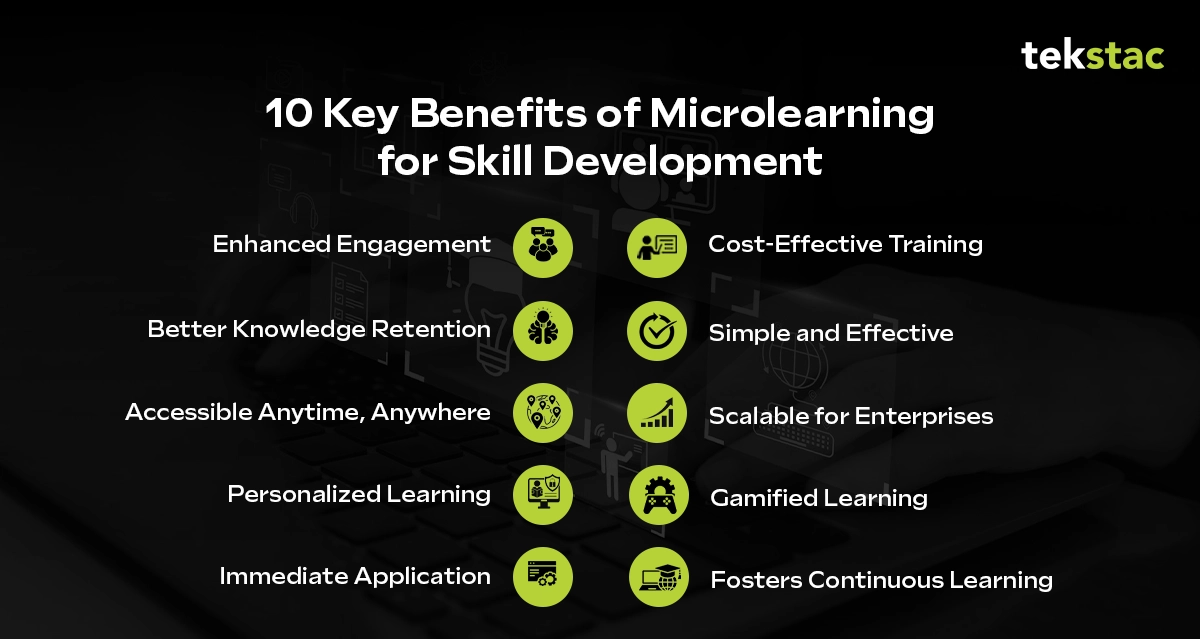
1. Enhanced Engagement Through Targeted Learning
Traditional training sessions often involve hours of presentations and discussions that can leave participants feeling disengaged and unclear about the key takeaways.
Rather than a full day of training, short, focused lessons provide precisely the insights needed. Studies show that microlearning enhances employee focus and boosts long-term knowledge retention by up to 80%.
Microlearning offers targeted, practical solutions tailored to specific needs, such as a brief module on negotiation techniques for sales professionals preparing for client pitches.
Small, focused lessons integrate seamlessly into busy schedules, helping learners remain engaged, prioritize essential topics, and develop relevant skills efficiently. This approach transforms training from a task to an integral part of professional growth, making it both practical and impactful.
As learners engage with focused lessons, the next critical step is ensuring that knowledge is retained and effectively applied over time.
2. Simplifying Knowledge Retention with Microlearning
Microlearning addresses a common pitfall of traditional training: the forgetting curve. Research shows that learners often forget up to 70% of new information within 24 hours if it isn’t reinforced. Simplifying knowledge retention with microlearning counters this by focusing on singular concepts per session. For example, employees learning a new software tool might complete short modules on specific features, followed by quizzes or interactive simulations to reinforce their understanding.
Platforms designed for microlearning could include built-in mechanisms to reinforce critical points through spaced repetition, quizzes, and real-world simulations.
These systems empower L&D teams to ensure employees periodically revisit key concepts, driving long-term retention and practical application. By emphasizing clarity and repetition, microlearning helps organizations build a workforce with a deeper understanding of critical topics, enabling immediate and effective application in professional scenarios.
As organizations prioritize accessibility, microlearning proves to be a flexible and effective tool for today’s global workforce.
3. Accessibility for a Global, Mobile Workforce
As hybrid and remote work models continue to rise, ensuring accessible and scalable training solutions has become a top priority for organizations. Microlearning addresses this need by offering mobile-friendly platforms that allow employees to engage with training materials anytime and anywhere. Whether during a commute, a quick break, or at the end of a busy day, microlearning seamlessly integrates into daily workflows, minimizing disruption while maximizing efficiency.
Modern skill development platforms take this flexibility a step further with features like offline access and responsive designs. Learning doesn’t have to pause, even when internet access is unreliable.
As accessibility enhances learning experiences, the next logical step is to ensure training paths are personalized for individual growth.
4. Personalized Learning for Individual Growth
Employees bring unique strengths, challenges, and career objectives to the workplace. Personalized learning for individual growth is achieved through microlearning platforms that leverage AI to develop tailored learning paths, aligning with the specific skills required for their roles and long-term goals.
In the coming years, over 47% of learning management systems (LMS) are projected to incorporate AI technology.
These platforms also provide real-time progress tracking through intuitive dashboards. When employees encounter difficulties, the system recommends alternative modules or customized learning methods to address their needs.
With personalized learning enhancing individual capabilities, the next step is ensuring those skills are applied effectively in real-world scenarios.
5. Immediate Application Through Real-World Scenarios
One of the key microlearning benefits is its ability to facilitate the immediate application of newly acquired skills. Knowledge transfer through real-world scenarios is achieved by creating practical lessons that align with organizational goals, ensuring that training directly supports workplace requirements. For instance, a brief, focused module on managing challenging customer interactions can empower teams to handle such situations more effectively.
Advanced platforms enhance this process by incorporating features like practice labs and case studies. As organizations seek impactful and efficient training solutions, microlearning offers a significant advantage in cost management and scalability.
6. Cost-Effective Training Solutions
Traditional training programs often demand high costs and effort. Companies need to hire trainers, rent venues, and provide printed materials. On top of that, employees lose valuable time away from their daily tasks, which impacts productivity. Cost-effective training solutions are offered through microlearning, which uses short, focused, and digital lessons to save both time and money.
Consider an organization training its customer support team on new AI-powered software. Instead of long, in-person sessions, employees can access quick lessons that guide them through real-world situations they might face while using the software. These lessons are easy to update as the software evolves, so the training always stays current without the need for a complete redesign.
With microlearning platforms, organizations can leverage internal expertise to develop content that directly aligns with their strategic objectives and operational requirements. This approach minimizes reliance on external consultants, ensuring training remains relevant, actionable, and tailored to specific business needs.
7. Making Learning Simple and Effective
Traditional training sessions often give too much information at once, making it harder for learners to remember or use what they’ve learned. Making learning simple and effective is one of the key microlearning benefits, as it breaks lessons into smaller, focused parts that are easy to follow and apply in real-world situations.
Some platforms take this a step further by using AI to monitor progress and adjust the pace of lessons to match the learner’s needs.
Simplified learning becomes even more valuable when it scales effectively to meet the demands of large organizations.
8. Scalability for Large Organizations
Global organizations face significant challenges in training employees across different time zones and languages. Microlearning addresses these pain points with flexible, self-paced modules that allow employees to learn on their schedules, regardless of location. Additionally, multilingual support ensures consistent, high-quality training delivery in the preferred language of each team member. Combined with robust progress tracking, microlearning provides a scalable, efficient solution to streamline workforce training for large enterprises.
While scalability ensures consistency, gamification takes engagement to the next level by making training enjoyable and rewarding.
9. Gamified Learning for Higher Engagement
Gamification turns training into an enjoyable and competitive experience. Gamified learning enhances engagement by making the learning process more interactive and enjoyable. Features like badges, points, and leaderboards on microlearning platforms add an element of fun and competition, motivating learners to stay actively involved.
These features can be aligned with organizational goals, rewarding employees for completing critical lessons or excelling in assessments.
10. Building a Culture of Continuous Learning
Microlearning is more than just a way to build skills—it helps create a culture of continuous learning. Building a Culture of Continuous learning happens by integrating training into daily routines, transforming learning from a one-time task into an ongoing habit that employees engage with naturally. This approach encourages them to take ownership of their growth, inspiring new ideas and strengthening the organization’s ability to adapt.
Platforms with features like reminders, progress trackers, and team collaboration tools make learning a smooth and natural part of work life. These tools not only keep employees motivated but also align their personal development with company goals, benefiting everyone involved.
Conclusion: Microlearning as a Game-Changer for Skill Development
Microlearning isn’t just another training method—it’s a smarter, easier way to help employees grow in today’s fast-changing world. By breaking learning into short, focused sessions, it makes picking up new skills simple and manageable. Complex topics are broken down into smaller lessons, keeping employees engaged and encouraging ongoing learning. This approach helps both individuals and the organization move forward together.
A good platform brings everything together seamlessly. Personalized lessons focus on what matters most, real-time feedback shows employees their progress, and practice tools build their confidence before they apply new skills at work. It’s not just about improving training—it’s about making learning practical, enjoyable, and part of everyday work life.
With microlearning, you’re not just equipping your team for today—you’re building a future-ready workforce prepared to handle whatever challenges come next, helping your business grow stronger along the way.
Transform your workforce with Tekstac. Leverage personalized learning paths, gamified modules, and real-time tracking to upskill your teams efficiently. Drive adaptability and build a future-ready workforce with ease.
What is Skill Development and Why Is It Crucial for Career Growth?
What is skill development?
Diya had a brainwave – A one-of-its-kind idea for what could be the next big thing in the world of start-ups. But she hesitates as she lacks the communication, presentation, and negotiation skills to pitch it to a set of angel investors.
In this context, what could change to help Diya advance in her endeavors and confidently pitch her brilliant idea? In today’s world, skill development is the path to progression as only technical know-how doesn’t suffice in building a successful career.
This raises the question – What is skill development? It is obtaining and enhancing skills and competencies for undertaking tasks effectively and delivering quality work. It is a process to develop and boost individual competency in personal, professional, or academic settings.
Skill development is essential for both personal and professional growth. Whether you are focusing on workplace training programs, career upskilling, or building essential job skills, continuous learning ensures long-term success.
Some examples of skill development could be a coder learning a new programming language, an entrepreneur taking up training in project management, or a fresher taking a course in digital marketing.
Why is skill development crucial for career growth?
Here are some reasons why skill development is important in career growth:
1. Adapting to an ever-changing job landscape
With AI and automation, the job market is more volatile than ever. The need of the hour is to be a professional who is agile, flexible, and capable of adapting to technological shifts through continuous skill development. Organizations today value employees with a mix of technical skills, soft skills, and digital fluency, making career upskilling and reskilling essential for long-term success.
For example – In fields like IT and Technology, medicine, and education, it is not just important but mandatory to adopt new skills and learn new programs. Investing one’s time and effort in continuous learning helps professionals stay relevant during accelerated developments and uncertainties.
2. To avail better career opportunities
By developing new skills, professionals can find avenues to new career opportunities and steady growth in their current designation or position. Research shows that those who dedicate time to upskill and reskill achieve faster career progression and are more likely to attain senior positions.
Organizations must consider this and endorse learning and development to help employees get faster promotions and salary growth.
For example – A professional could get new certifications or seek training in some areas to position oneself as an SME or expert in their field and accordingly negotiate for higher salaries.
3. For better productivity and efficiency
Enhancing your skills leads to greater efficiency and improved productivity at work. Learning modern tools through skill development reduces manual tasks, allowing professionals to focus on strategic initiatives. In fact, companies that invest in employee training see a 24% higher profit margin than those that don’t, highlighting the direct impact of continuous learning on business success.
For example – developing advanced Excel skills can help a professional in the automation of repetitive tasks, finish complex calculations quickly, save time in decision-making, and perform faster and more detailed analyses.
In terms of boosting efficiency, enhancing their skill set can help professionals make fewer errors, and enhance collaboration at work.
4. Being prepared for competition
Employers are looking for professionals with the right skills for innovation and higher efficiency. If you are a professional looking for a job change or aiming to change your career path, then here are some things to do –
- Create a top-notch portfolio to highlight your expertise
- Stay updated with the latest advancements and trends
- Conduct regular self-assessment to identify gaps in knowledge
In a market inundated with candidates having similar qualifications and educational backgrounds, developing valuable skills can help you stand out.
What are some off-beat yet effective ways to develop your skills?
No matter what your budget is, these are some lesser-spoken of but effective ways to develop skills and enhance your abilities:
Finding a mentor
One of the best ways to develop your skills is to find a mentor who will offer you guidance and support related to a specific skill, honing leadership skills, or developing industry knowledge. It could be a senior professional, an industry leader, or a career coach – they will help you identify areas needed for development.
While reaching out to a mentor, please specify what you hope to achieve from the mentorship and how they are a good fit for guiding you. Also, mentorship is truly effective when it is a two-way street wherein, they offer guidance and you can share your insights from your work or skills. You could also offer to assist them where you could help them with research, brainstorm with them, or manage a project.
Volunteering
Probably one of the best ways to help people as well as develop a skill set is to sign up for volunteering with a colleague at your workplace by assisting on a project or by joining a non-profit organization. You could also look for volunteering positions on Google or newsletters to find positions that would benefit your career. This is an underrated yet ideal way to get hands-on experience leading to top-notch job offers and standing out in the job market.
Shadowing experts
Shadowing experienced professionals in a field of your choice is an excellent way to develop practical knowledge, extend your know-how beyond textbooks, and fill the gap between theory and practice. One can shadow professionals by observing the work they do, understanding the methods they use, and the decision-making processes they leverage in real-world situations.
Less explored yet effective ways like finding a mentor or volunteering help enhance skills, with platforms like Tekstac helping organizations offer personalized mentorship and learning paths, thus improving skill development and career prospects.
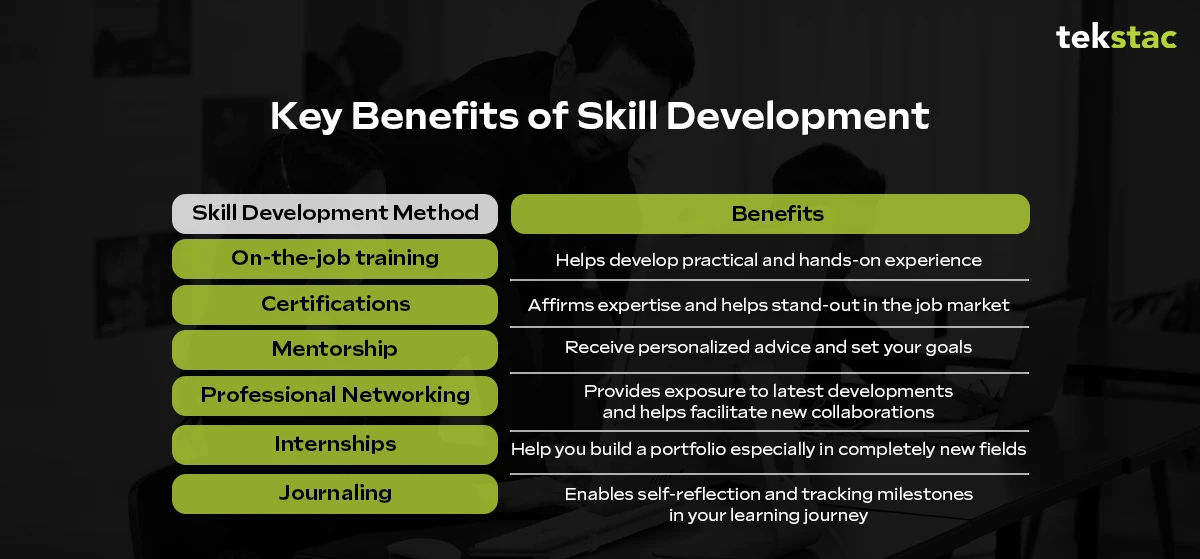
In a nutshell
Skill development extends beyond learning, helping you realize full potential and rise to the challenges stemming from an ever-changing job market. Schedule some time on a bi-weekly or monthly basis to assess your current skill set and attend training & workshops to improve on those areas.
Develop a solid professional network on a social media platform like LinkedIn to check if your current skill set matches the industry standards, collaborate on projects and exchange notes on best practices and tools.
Maintain a journal to track how your skills evolve with time, stay motivated to achieve your goals and reflect on takeaways from learnings in online courses or training sessions.
10 Key Pre-Hiring Assessment Trends for 2025: How AI is Shaping Recruitment
In the rush to fill a position with the right candidate, many organizations overlook the importance of pre-hiring assessments, leading to costly hiring mistakes. Without proper evaluation methods in place, businesses risk selecting candidates who may not be the right fit for the role.
A bad hire isn’t just someone missing a skill or two; they can be expensive. According to CareerBuilder, a bad hire costs at least $18,700 for executive-level positions and more than $37,150 on average for Indian companies. Beyond financial loss, bad hires contribute to decreased productivity, low morale, and higher turnover rates, which impact overall business performance.
Why Are Companies Making Such Costly Hiring Mistakes?
A CareerBuilder survey revealed the top reasons for bad hires:
- 54% of companies found that the hires produced low-quality work
- 45% reported that the candidates’ skills didn’t match their claims
- 53% said the employee didn’t have a positive attitude
This data underscores the importance of accurate pre-hiring assessments. Organizations often rely on outdated hiring methods, focusing too much on resumes and interviews without truly assessing candidates’ skills. Fortunately, with advancements in technology and the growing adoption of AI, recruiting high-quality candidates has become more efficient and precise.
Understanding the role of AI in pre-hiring assessments
As of July 2024, 88% of companies globally use Artificial Intelligence (AI) for HR practices, according to LinkedIn’s Future of Recruitment Playbook.
AI can rapidly analyze vast amounts of candidate data—ranging from resumes to assessments—to identify hires that align with top-performing talent already within an organization. Beyond identification, AI enhances pre-hire assessments by designing tests that evaluate both technical and soft skills crucial for high performance.
Organizations using AI-driven pre-hire assessments are 46% more likely to find successful, skill-fit hires (CareerBuilder, 2024). These assessments are based on real-world job scenarios, ensuring candidates are not only skilled but also ready to perform from day one.
Additionally, AI-driven tools enhance assessment integrity by monitoring for suspicious activities and evaluating cultural fit, significantly reducing turnover.
Top 10 pre-hiring assessment trends for 2025
With AI and recent technologies in the market, pre-hiring assessments are evolving in how candidates are assessed.
Below are the top 10 pre-hiring assessment trends HR must watch out for:
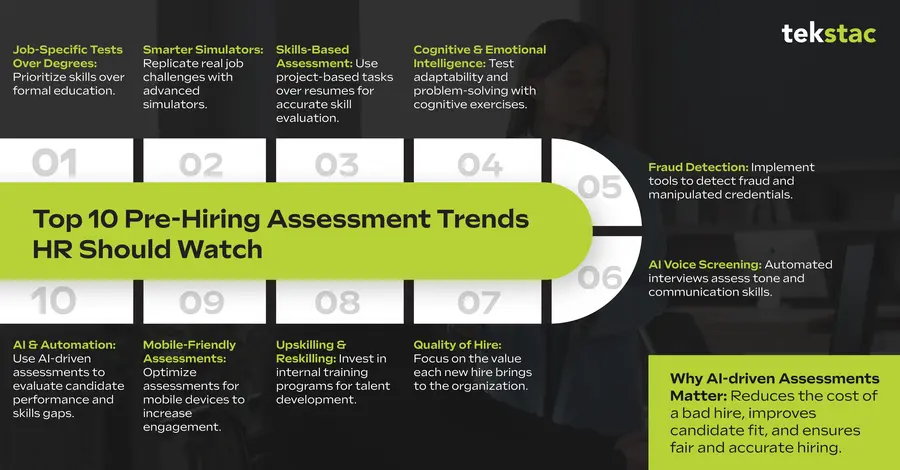
1. The rising focus on job-specific tests over degrees
Companies are increasingly prioritizing skills over formal education. According to a recent McKinsey report, organizations are re-evaluating degree requirements and shifting toward skills-first hiring. This means talent acquisition teams will need to invest in job-specific tests that accurately measure the skills necessary for success in a role.
Hiring managers are now leveraging AI-powered competency frameworks that break down required skills for each position, ensuring a precise match between the job description and the candidate’s capabilities. This shift opens doors for non-traditional candidates, enabling companies to tap into a wider and more diverse talent pool.
2. The evolution of simulators in pre-hiring
Advanced simulators are becoming integral in assessing practical skills. They replicate real-world challenges to evaluate candidate performance. For instance, coding simulators test a developer’s debugging abilities, while customer service simulators assess how well candidates handle client inquiries.
Simulations provide a hands-on approach, allowing candidates to showcase their abilities in real-time. This trend is particularly prominent in IT, healthcare, and finance industries, where job performance depends heavily on applied knowledge.
3. Skills-based pre-hire assessment will dominate
Companies are moving beyond traditional resumes and interviews, favoring skills-based interviews, project-based assessments, and job-focused tasks. This shift reduces reliance on self-reported claims and ensures hiring decisions are based on proven competencies.
HR teams are adopting AI-driven skills assessment platforms that use adaptive testing to evaluate candidates dynamically, adjusting difficulty levels in real-time based on responses.
4. Cognitive testing for full talent evaluation
Employers recognize the importance of hiring candidates with strong cognitive and emotional intelligence. Assessments now include problem-solving tasks, role-playing scenarios, and situational judgment tests to minimize the risk of hiring cultural misfits.
AI-driven cognitive testing evaluates not only logical reasoning but also adaptability, creativity, and emotional intelligence—factors that contribute significantly to job performance and teamwork.
5. Fraud detection becomes mandatory
With the rise of AI-generated resumes and fraudulent applications, companies must implement assessment tools with built-in fraud detection. AI-driven hiring platforms can now verify credentials, detect inconsistencies, and prevent hiring mistakes based on manipulated data.
With features like plagiarism detection and remote proctoring, AI ensures that candidates take assessments honestly, making it easier to top talent based on merit.
6. AI voice pre-screening in early hiring stages
AI-powered voice screening is revolutionizing initial candidate assessments. These systems analyze communication skills, tone, and response patterns to generate insights for recruiters. However, organizations must ensure these technologies align with DEI (Diversity, Equity, and Inclusion) goals to prevent bias.
7. Measuring ‘quality of hire’ over quantity
With declining global hiring volumes, companies are shifting focus from the number of hires to the value each new hire brings. According to LinkedIn’s Future of Recruitment 2024 Playbook, measuring “quality of hire” through AI-driven analytics and post-hire performance tracking will be a key metric in talent acquisition.
Quality-of-hire metrics are calculated based on onboarding success, performance ratings, productivity levels, and retention rates within the first year of employment.
8. Upskilling and reskilling as a hiring strategy
Companies struggling to find skilled candidates externally increasingly turn to upskilling and reskilling programs for existing employees. Employees must participate in training programs followed by assessments to check their suitability. This approach to building a skilled workforce reduces excessive reliance on external hiring and at the same time, improves employee retention and reduces overall cost.
9. Mobile-friendly assessments to drive candidate engagement
With mobile devices now dominating internet usage, candidates expect to complete hiring assessments on their smartphones. Companies are optimizing pre-hire tests for mobile accessibility, enabling candidates to participate conveniently.
This shift increases application completion rates and allows companies to reach a wider talent pool, including gig workers and passive candidates.
10. AI and automation for smarter pre-hiring assessments
Along AI tools are enhancing resume screening, automated interview evaluations, and candidate performance analysis. They generate detailed reports highlighting skill gaps and strengths, providing HR teams with data-driven hiring insights.
Automated pre-hire assessments reduce human bias and accelerate the hiring process, allowing recruiters to focus on strategic decision-making rather than administrative tasks.
Why investing in AI-driven pre-hiring assessment tools is a smarter choice
Training and onboarding costs add an average of $1,252 per employee and 10+ hours of HR time.
Traditional hiring methods are proving insufficient in identifying the best candidates, making AI-driven pre-hiring assessments the most effective alternative in 2025.
For organizations hiring tech talent, specialized platforms such as Tekstac are transforming recruitment with competency-based assessments, real-time AI-driven proctoring, and automated candidate evaluation. These platforms offer integrity-focused hiring solutions, ensuring fairness, accuracy, and data-backed decision-making.
Final Thoughts
With hiring trends evolving rapidly, AI-driven assessments are becoming indispensable. Organizations investing in smart, data-backed hiring solutions will gain a competitive advantage, ensuring they onboard the right talent for long-term success.
To stay ahead, companies must explore AI-powered tools that align with their hiring goals—ushering in a new era of efficient, skills-based recruitment.
5 Must-Read Learning and Development Books for Professionals in 2025
The field of Learning and Development (L&D) is constantly evolving, driven by rapid advancements in technology, changing learner needs, and innovative training methodologies. To stay relevant and ahead of the curve, L&D professionals must keep themselves updated with the latest insights, tools, and strategies.
Looking for the best Learning and Development books in 2025? Here are five must-read books to help L&D professionals enhance employee training, instructional design, and strategic learning.
5 Best Learning and Development Books to Read Professionals in 2025
- Artificial Intelligence for Learning – How to use AI to Support Employee Development – Donald Clark
- Design for How People Learn – Julie Dirksen
- Make It Stick: The Science of Successful Learning – Peter C. Brown, Henry L. Roediger III, Mark A. McDaniel
- Map It: The Hands-on Guide to Strategic Learning Design – Cathy Moore
- Design Thinking for Training and Development – Sharon Boller, Laura Fletcher
These books provide valuable insights into modern learning strategies, AI-driven training, and effective instructional design. Let’s explore how each book can help Learning and Development professionals enhance their skills, design impactful training programs, and leverage AI for better employee development.
1. Artificial Intelligence for Learning – How to use AI to Support Employee Development
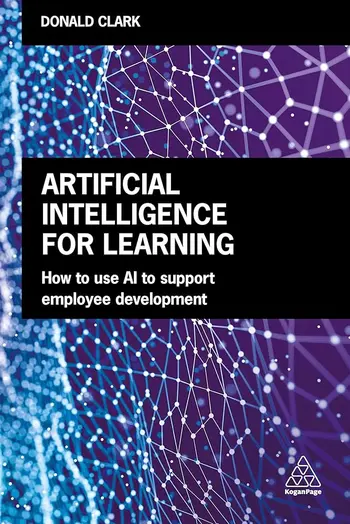
- Author: Donald Clark
- Rating: 4.7
- Publish Date: 2020
- Pages: 320
Summary:
Artificial Intelligence for Learning: How to Use AI to Support Employee Development by Donald Clark is a practical guide for leveraging AI in workplace learning and development. The book provides specific guidance on how AI can enhance content curation, personalization, and learner engagement. It also covers the use of AI to improve the efficiency of evaluation, assessment, and reporting, and how chatbots can support a global workforce. Clark debunks myths about AI, emphasizing its role as an aid rather than a replacement for human-led learning. The book includes real-world examples and case studies from organizations like Netflix and British Airways, demonstrating the tangible benefits of AI in learning and development.
2. Design for How People Learn

- Author: Julie Dirksen
- Rating: 4.7
- Publish Date: 2011
- Pages: 259
Summary:
Design for How People Learn by Julie Dirksen explores the intersection of instructional design and cognitive psychology to create effective learning experiences. The book is divided into three parts: understanding the principles of learning, applying these principles to design, and designing for different types of learners. Dirksen emphasizes the importance of creating engaging, memorable, and personalized learning experiences. She discusses how people learn through experience, the role of memory, and the importance of motivation. The book also covers practical aspects like providing feedback, ensuring accessibility, and evaluating the effectiveness of learning designs.
3. Make It Stick, The Science of Successful Learning
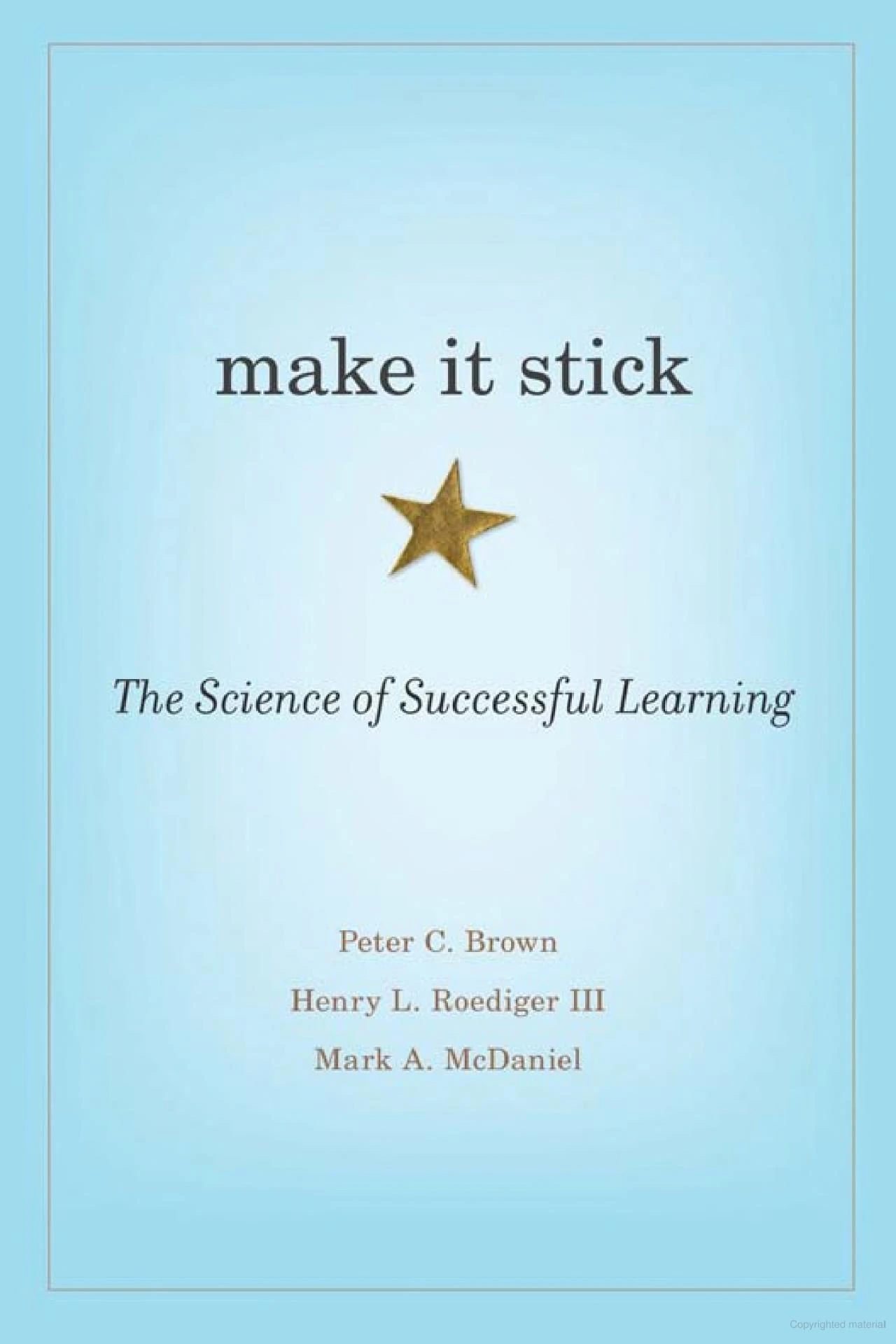
- Authors: Peter C. Brown, Henry L. Roediger III, Mark A. McDaniel
- Rating: 4.6
- Publish Date: 2014
- Pages: 313
Summary:
Make It Stick: The Science of Successful Learning by Peter C. Brown, Henry L. Roediger III, and Mark A. McDaniel explores evidence-based techniques for effective learning. The authors emphasize that traditional study methods like rereading and cramming are less effective than strategies such as spaced repetition, retrieval practice, and interleaving. They highlight the importance of making learning effortful, as this leads to better retention and understanding. The book also discusses the role of feedback, the benefits of varied practice, and the impact of beliefs about learning on performance. By applying these principles, learners can improve their ability to retain and apply knowledge effectively.
4. Map It: The Hands-on Guide to Strategic Learning Design
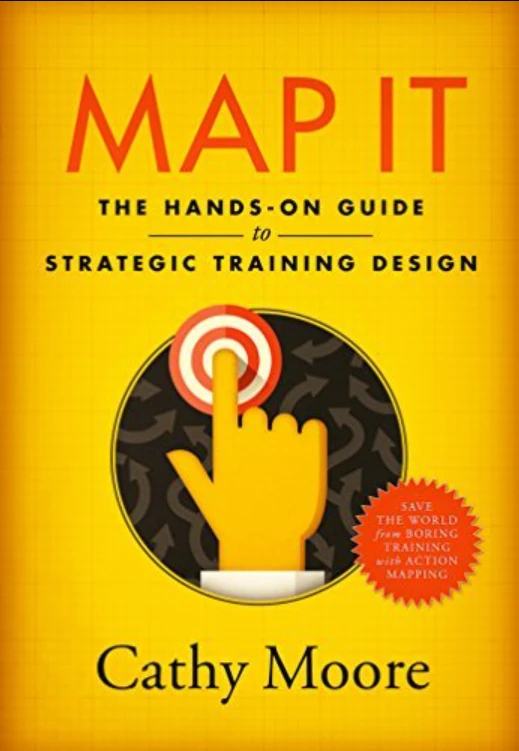
- Author: Cathy Moore
- Rating: 4.7
- Publish Date: 2017
- Pages: 406
Summary:
Map It: The Hands-on Guide to Strategic Learning Design by Cathy Moore is a practical guide for creating effective training programs that address real business needs. The book introduces the concept of action mapping, a visual approach to needs analysis and training design. Moore emphasizes identifying the root causes of performance problems and designing realistic activities that help learners practice what they need to do, rather than just absorbing information. The book provides step-by-step instructions on how to create engaging and impactful training solutions, choose the best formats for activities, and ensure that training is delivered at the right time. By focusing on practical application and avoiding information dumps, Moore aims to improve both individual performance and organizational outcomes.
5. Design Thinking for Training and Development
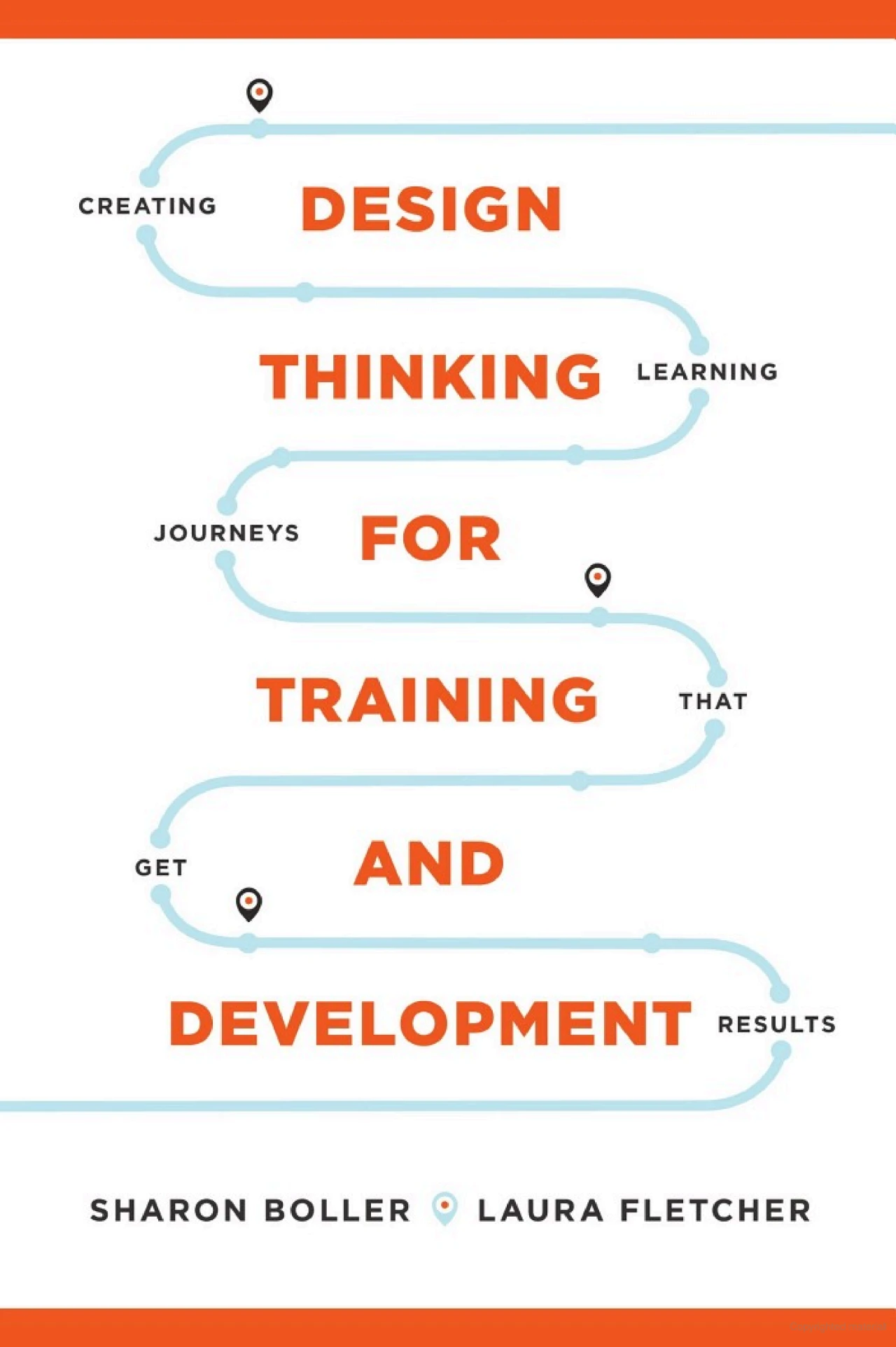
- Authors: Sharon Boller, Laura Fletcher
- Rating: 4.6
- Publish Date: 2020
- Pages: 274
Summary:
Design Thinking for Training and Development by Sharon Boller and Laura Fletcher provides a practical guide to applying design thinking principles to create effective learning experiences. The book emphasizes a human-centered approach, involving learners in the design process to ensure training meets their needs and drives performance improvement. Key steps include gaining perspective, refining the problem, ideating and prototyping, iterating through development and testing, and implementing the solution. The authors highlight the importance of balancing learner needs, business goals, and constraints, and provide tools like empathy maps and experience maps to enhance the learning design process.
Conclusion
In a dynamic field like L&D, continuous learning is key to staying relevant. The books on this list offer timeless principles, actionable insights, and proven techniques that can help you advance your skills and create meaningful learning experiences. Whether you’re designing a new program, leading a training session, or supporting learners through their professional journey, these books are invaluable resources for every stage of your career. Happy reading, and here’s to a successful and impactful 2025!
Skills Management vs. Talent Management: What’s the Difference?
Blending Skills and Talent Management for Effective Team Success
Effective team management is not about choosing one method over another but blending strategies to ensure both immediate performance and long-term growth. Skills management focuses on honing specific abilities critical for current roles, while talent management emphasizes nurturing employees’ overall potential to support future organizational goals. Together, these approaches complement each other, creating a workforce that is resilient, capable, and prepared for the challenges ahead.
The Role of Skills Management in Workforce Excellence
Skills management is all about understanding what you and your team need to thrive in your roles and helping everyone grow in those areas. It starts with figuring out the gaps—what’s missing for you or your team to perform your best—and then creating targeted employee training programs to bridge those gaps.
When done right, it doesn’t just boost productivity; it builds stronger, more capable teams that are ready for anything. Take Amazon’s Career Choice program, for example. Amazon equips its employees with the tools to achieve their personal goals while meeting the company’s future needs.
But let’s be honest – it’s not just about sitting through lectures or flipping through manuals. Real learning happens when it’s hands-on. Practical training gives you the confidence and experience to handle real-world challenges. And with regular check-ins, you can see just how far you’ve come and whether the employee training programs are making a difference. This way, your team can adapt quickly to new projects or technologies without wasting any time.
Understanding Talent Management for Long-Term Growth
Skills management and talent management aren’t separate ideas—they’re two sides of the same coin. Talent management is all about nurturing your employees’ potential and supporting their long-term growth within your organization. It begins the moment they join your team and continues as they build meaningful careers aligned with your company’s goals.
A great example is Google’s focus on employee development, where programs like mentorship, leadership training, and growth-focused initiatives provide clear paths for career advancement. It’s all about helping your employees grow from their very first day and guiding them to build meaningful careers within your company. These strategies not only retain top talent but also foster innovation within the organization.
Did you know that 52% of employees who leave their jobs say their employer could have done something to stop them? People stay when they feel valued, appreciated, and see chances to grow. When you recognize their efforts and show them support, they’re much more likely to stick around and contribute to your success.
The Interplay Between Skills and Talent Management
To future-proof your workforce, integrating skills management and talent management is key. Skills management equips your team with the specific capabilities they need right now, ensuring operational efficiency. Talent management, on the other hand, focuses on nurturing long-term potential through mentorship, leadership development, and tailored career plans.
By aligning these strategies, you not only close skills gaps but also empower employees to grow in ways that directly support your business goals. This holistic approach helps you adapt to market changes, foster engagement, and retain top talent in a competitive landscape.
Challenges in Implementing Skills and Talent Management
Implementing skills and talent management isn’t easy, especially with the constant change in skills required to perform a role and the rapid evolution of technology. It can be challenging to pinpoint skill gaps and keep training programs relevant. Your employees may also disengage if they don’t see how the learning ties to their growth.
Aligning career advancement with your business goals adds complexity, as mismatches can lead to frustration. By using real-time tools to track trends, creating tailored development plans, and fostering a culture of growth, you can help your team stay prepared and motivated to succeed.
Skills Management vs. Talent Management: A Comparative View
Skills management and talent management share a common goal-building a strong workforce-but they approach it in different ways. Here’s how they compare:
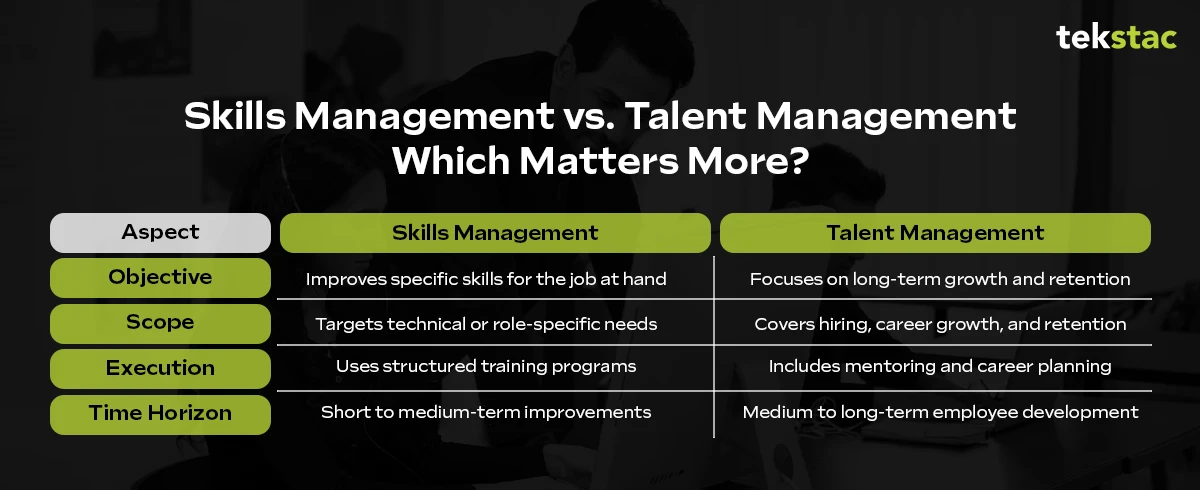
Together, these two approaches form a balanced strategy. Skills management addresses immediate needs, while talent management ensures sustainable, long-term success for both employees and the organization.
1. The Rise of Skills-Based Talent Management
Skills-based talent management is changing the way companies think about their workforce. Instead of focusing on job titles, this approach looks at what employees can actually do. This approach prepares teams to navigate challenges and seize opportunities with confidence and agility.
This method helps organizations use their people more effectively. Employees are assigned tasks based on their abilities, not just their roles, which makes projects run smoother and faster. It also brings different talents together, encouraging teamwork and creative problem-solving.
2. Enabling Workforce Success Through Integrated Strategies
If you want your organization to succeed in today’s fast-changing world, you need a strategy that brings skills management and talent management together. This means using tools that enable effective skills gap analysis to give you a clear picture of what your team can do now and how they can grow. By addressing immediate needs while planning for the future, you’ll set your workforce up for long-term success.
With advanced learning and development systems, it’s easier than ever to create focused employee training programs that actually work. This approach doesn’t just improve productivity; it enhances employee engagement and ensures your organization stays competitive in a rapidly evolving marketplace.
Conclusion
Skills management and talent management are two complementary parts of a unified strategy for building a stronger workforce. Together, they ensure your employees are equipped with the skills they need today while fostering the growth required for tomorrow. Skills management sharpens capabilities for immediate tasks, and talent management aligns personal aspirations with organizational goals, creating a seamless pathway for success.
With tools like Tekstac’s advanced learning platforms, organizations can bridge skill gaps, foster career growth, and build a resilient workforce ready for the future. Take the next step in workforce transformation—explore Tekstac’s solutions today to set your team up for lasting success.
FAQs
1. What is the difference between talent management and talent development?
Talent management focuses on hiring, retaining and optimizing employees, while talent development enhances employees’ skills through training and mentorship. Talent development is a key part of talent management, ensures long-term growth and success.
2. How can organizations future-proof their workforce with skills and talent management?
By leveraging skills gap analysis, tailored learning programs, and career development initiatives, companies can ensure employees stay adaptable and aligned with evolving business needs.
3. What is the difference between Talent Management and Learning & Development in HRM?
Talent management focuses on hiring, performance, and career growth, while Learning & Development (L&D) enhances skills through training. L&D is a key part of talent management, driving workforce growth and readiness.
4. What tools can help implement skills and talent management effectively?
Platforms like Tekstac’s advanced learning solutions enable organizations to analyze skill gaps, provide personalized training, and drive long-term workforce transformation.
5. How do skills management and talent management work together?
Skills management ensures employees have the right capabilities for immediate tasks, while talent management focuses on long-term growth through mentorship and career planning. Together, they create a balanced workforce strategy.
Top 10 Holiday Season Gifting Ideas for HR Leaders
The holiday season is here; time to spread cheer, share joy, and show appreciation to the unsung heroes of every workplace- Human Resource (HR) leaders. They’re the ones fostering culture, boosting morale, and ensuring everyone feels valued year-round.
But finding the perfect gift can be as tricky as untangling last year’s Christmas lights!
Don’t worry! We’ve got you covered.
10 Holiday Season Gifts Your HR Leaders Will Love in 2025
We’ve curated 10 unique gift ideas that combine thoughtfulness with practicality to help you show your gratitude this holiday season.
Sounds like a lifesaver, right? Let’s dive in!

1. Personalized Desk Accessories
A desk is more than just a workspace; it’s where HR leaders manage countless tasks, plan initiatives, and brainstorm ideas.
So why not give their workspace a touch of personality and functionality?
Unique custom desk accessories can spruce up any workspace. Whether it’s a name tag or a stylish leather desk organizer, these gifts are both practical and thoughtful. A monogrammed pen set, or personalized planner adds a touch of elegance to their desk & can make their daily tasks feel a little more special.
Why they’ll love it!
- Adds a personal touch to their workspace.
- Functional and stylish, perfect for the HR leader who loves staying organized.
- A constant reminder of gratitude from the team.
2. Tech Gadgets for Productivity
Tech-savvy gifts are always a hit. Consider gadgets that make their busy lives easier, such as wireless charging pads, noise-cancelling headphones, or portable power banks. These tools cater to their need for efficiency and convenience. For an extra special touch, go for premium tech brands or customizable options.
Why they’ll love It!
- Enhances productivity during their demanding days.
- Blends utility with modern design.
- Offers long-term value.
3. Books on Leadership and Personal Growth
HR leaders are lifelong learners, always striving to improve their skills and lead their teams better. A book on leadership, team dynamics, or personal growth can provide them with fresh insights and inspire them in the year ahead. Bestsellers like Leaders Eat Last by Simon Sinek or The Culture Code by Daniel Coyle, Dare to Lead by Brené Brown or The 5 Levels of Leadership by John C. Maxwell are great choices.
Why they’ll love it!
- Fosters their growth as leaders.
- Provides fresh perspectives and insights.
- A gift that can shape their leadership style for the future.
4. Sustainable Gifts
For eco-conscious leaders, consider gifts like bamboo organizers, solar-powered gadgets, or zero-waste kits. A personalized reusable water bottle or stylish tote bag can also align with their values.
Why they’ll love it:
- Supports sustainability and reflects mindfulness.
- Practical for daily use.
- Shows you care about their values.
5. Fitness and Outdoor Gear
Help them kick off their New Year resolutions with premium fitness accessories. Options include resistance bands, a compact home workout set, or outdoor gear like a hiking backpack or insulated water bottle.
Why they’ll love it:
- Encourages a healthy lifestyle.
- Great for staying active or enjoying outdoor adventures.
- A gift that supports their goals.
6. Wellness or Self-Care Kits
After managing multiple employee issues, performance reviews, and navigating organizational changes, HR leaders deserve some self-care. A wellness kit filled with essential oils, luxurious candles, or a spa day voucher will help them unwind and de-stress. They’ll surely appreciate a gift that promotes relaxation during the holiday season.
Why they’ll love it:
- Focuses on their well-being and helps them recharge.
- Thoughtful and rejuvenating gift.
- Shows that you value their mental health and well-being.
7. Subscriptions for Learning or Fun
A subscription service can be a deeply thoughtful gift, offering your HR leader consistent value over time. Instead of a one-off present, a subscription becomes a gift that keeps giving. Depending on their interests, you could choose a MasterClass membership, a coffee bean delivery service, or a subscription to a streaming platform like Spotify or Audible.
Whether it’s for professional growth or personal enjoyment, a subscription offers flexibility and shows you’ve considered their unique preferences.
Why they’ll love it:
- Creates recurring moments of joy for a longer period.
- Tailored to their unique hobbies or aspirations.
- Combines utility with a personal touch.
8. Gourmet Gift Baskets
Everyone loves a little indulgence, and a gourmet snack or coffee basket is a safe bet. Fill it with artisanal chocolates, premium coffee blends, or organic snacks that they can enjoy during their downtime. Add a personal note, and you’ve got a thoughtful gift that feels both festive and practical.
Why they’ll love it:
- Delicious and perfect for sharing with family or colleagues.
- Simple yet elegant, something they’ll enjoy during the holiday season.
- A thoughtful gesture that doesn’t break the bank.
9. Artisan Handcrafted Gifts
Nothing speaks more deeply than a piece crafted with care and artistry. Gift unique, handcrafted items like hand-thrown mugs, vases, pottery, woven blankets, or artisanal wall art. Supporting local or global artisans adds a layer of meaning and originality to your gift.
Why they’ll love it:
- One-of-a-kind and meaningful.
- Adds a personal and artistic touch to their space.
- Supports craftsmanship and small businesses.
10. A New Adventure
Sometimes, the best gifts are experiences. Gift your HR leader an experience-based present like a voucher for a fancy dinner, a fun activity, or a ticket for a music concert. Whether they’re into fine dining, wine tasting, or learning a new skill, gifting them with an experience allows them to create new memories. Some more options to consider are spa voucher, tickets to a sporting event, or an online cooking class they can enjoy at their own pace.
Why they’ll love it:
- Flexible and memorable, no need to choose the perfect item when they get to decide!
- A gift that encourages self-care, relaxation, and fun.
- Perfect for the HR leader who values experiences over material things.
Wrap-Up: A Gesture of Gratitude
This holiday season, step outside the traditional box and surprise your leaders with gifts that are innovative, meaningful, and tailored to their unique style. Whether you choose something techy, artistic, or experiential, these ideas are bound to make their Christmas and New Year unforgettable.
What’s your favorite pick? Let the gifting magic begin!
Skills Tracking: Boosting Employee Growth Post-Onboarding
Imagine young athlete Serena Williams joining a training academy but stops tracking her progress. Would she have reached her legendary status? Like athletes, employees require ongoing tracking of their skills to stay in tune with changing business needs. Employee development is not a one-time affair but a journey. Skill tracking is a critical requirement that helps in tracking growth, skills gaps, and learning that is aligned with the goals of the organization.
Effective skill tracking systems would enable personalized learning paths, real-time feedback, and eventually shape the culture of ongoing learning to meet the organizational goals and contribute towards the success of a business with professional growth.
The Importance of Skills Tracking
76% of employees are looking for upskilling and reskilling opportunities for career development. Skill progress tracking enables the tracking of employees’ continuous development. It ensures that after onboarding, employees are still progressing. Organizations can track where skills gaps exist, adjust their training efforts, and tailor learning interventions to meet business and employee needs by tracking skills.
Role of Technology in Skills Tracking
Technology plays a very important role in tracking skills by making it easier to monitor and improve skills. It automates the tracking process through learning management systems, AI-driven assessments, and other platforms, which provide real-time updates on progress. These applications recommend courses relevant to the individual’s needs. Data analytics helps in the delivery of insights regarding employee strengths and weaknesses, hence allowing organizations to make informed decisions on training and development.
Continuous feedback and performance measurement are also made possible, keeping employees on track. This simplified skill-tracking process enables organizations to ensure constant learning, better performance among employees, and align workforce development with organizational goals.
![]()
1. Learning Paths for Growth
Skill tracking is not only about measuring progress but it is an opportunity for constant growth. With active tracking and assessment of skill development, it is possible to develop meaningful improvement paths for organizations. Tekstac’s customizable learning paths take this concept further by ensuring the development of skills that fit organizational goals and individual competencies of employees. Such customized journeys keep the employees motivated and engaged to improve their skills and abilities.
2. Targeted Interventions and Skills Gap
Competency mapping helps determine the areas where skills gaps are present, so the employee receives targeted training based on their job. Immersive practice labs, live sessions, and expert mentoring are a few resources organizations can use to close those gaps effectively.
3. Real-Time Analytics for Informed Decision-Making
Real-time analytics makes tracking skills easier because, within a few minutes, it provides an update on where employees are learning and improving. It gives organizations the rationale for training decisions based on how these employees are progressing. For managers, this information allows them to change plans, facilitate support, and utilize organizational resources more effectively. Employees see instant feedback, which helps them to stay focused and finish goals more quickly.
Tools with real-time analytics allow both employees and organizations to know clear results and take action promptly. This way, skill development stays on track and promotes growth for the organization and the individual.
4. Improving Employee Accountability and Motivation
Tracking skills not only supports employee growth but also creates responsibility. Employees can see their development and compare it to a standard benchmark. Skill tracking motivates employees to improve and learn continuously. Some tools have features that enable setting up milestones and tracking employee development toward specific predetermined goals, therefore motivating them toward engagement. Such a system will then go on to promote a sense of accomplishment as well as a culture of continuous learning. Employees will eventually take charge of their growth; the better organizations are going to have a more skilled and more engaged workforce.
5. Scaling Skill Development Across the Organization
Scaling skill development across an organization ensures that the organization is growing and ready to face the evolving business challenges. Training thousands of employees for large-scale programs and assuring that each gets attention is a challenge in itself. Tekstac counters this challenge with scalable solutions handling thousands of simultaneous learning journeys.
This scalability of an enterprise level could enable organizations to track the development of a large team’s skill progress, whether it is tracking upskilling existing staff members or new hires in the development process. Some platforms are designed with security and high levels of performance in mind to meet the demands of growing businesses.
6. Predicting Future Skill Needs Through Analytics
Predicting the future need for skills through analytics will keep organizations ahead of the game in a rapidly changing market. Organizations must operate several steps ahead of the trends within an industry. Through the integration of progress tracking with predictive analytics, organizations can predict future needs for their workforce and thus prepare the right workforce for their business.
Businesses use these insights to create focused training programs, align talent strategies with goals, and optimize workforce readiness. In this way, an organization enhances its competitiveness while improving the engagement of employees and, more importantly, creates a culture of continuous growth and innovation.
Conclusion
In short, skill tracking is key to making employee growth post-onboarding thrive. It equips the organization with the tools to track performance, close gaps, and design personalized developmental plans. An all-in-one platform like Tekstac makes tracking easier for organizations, allowing for maximum support for their workforce. Being offered a gamut of features ranging from real-time analytics to hands-on practice labs by Tekstac facilitates business learning and development, leading to long-term success.
By incorporating competency mapping into the employee growth strategy, organizations are assured to be evolving, adapting, and thus contributing toward their overall business success. In fact, Tekstac is bringing innovative solutions which enable organizations to further scale their talent development efforts, through total employee empowerment so that an employee can see the full scope of his potential.
Get started with Tekstac today and empower your workforce to grow, adapt, and succeed. Contact us to learn more about how we can support your team’s skill development journey.
5 Strategies for Employers to Conduct Skills Gap Analysis Before Upskilling
Bridging skills gap
“72% of employers are struggling to find employees with the right skills” says a report from Deloitte on workforce challenges.
Understanding and addressing skills gaps is crucial for designing effective upskilling programs. A thorough skills gap analysis allows organizations to focus on priority areas, ensuring resources are allocated where they can have the most significant impact.
With a clear understanding of these gaps, it becomes possible to develop targeted strategies that strengthen workforce capabilities and enhance adaptability to future challenges. Structured approaches to skills gap analysis and upskilling not only identify areas for improvement but also guide the selection of relevant programs. Aligning these efforts with industry trends ensures the workforce stays competitive and prepared for evolving demands.
What is a skills gap?
A skills gap occurs when the skills an employer needs from their workforce exceed the current capabilities of their employees.
The survey by American Staffing Association (ASA) highlights the challenges organizations face due to skills gaps.
Skills gap analysis helps track and measure the workforce gap between abilities and competencies required and currently possessed. HR leaders can evaluate this using different methods like competency assessments, performance reviews, and employee surveys. Upskilling, or skills-based learning is a prominent way to address the skills gap.
Upskilling without identifying the skills gap is like solving a problem you don’t understand. Targeted skills insights ensure every effort drives measurable impact and growth.
5 Strategies for skills gap analysis before upskilling
Organizations can follow various methods to do a skills gap analysis. Here are a few powerful strategies to be followed by employers to identify skills gaps before upskilling.
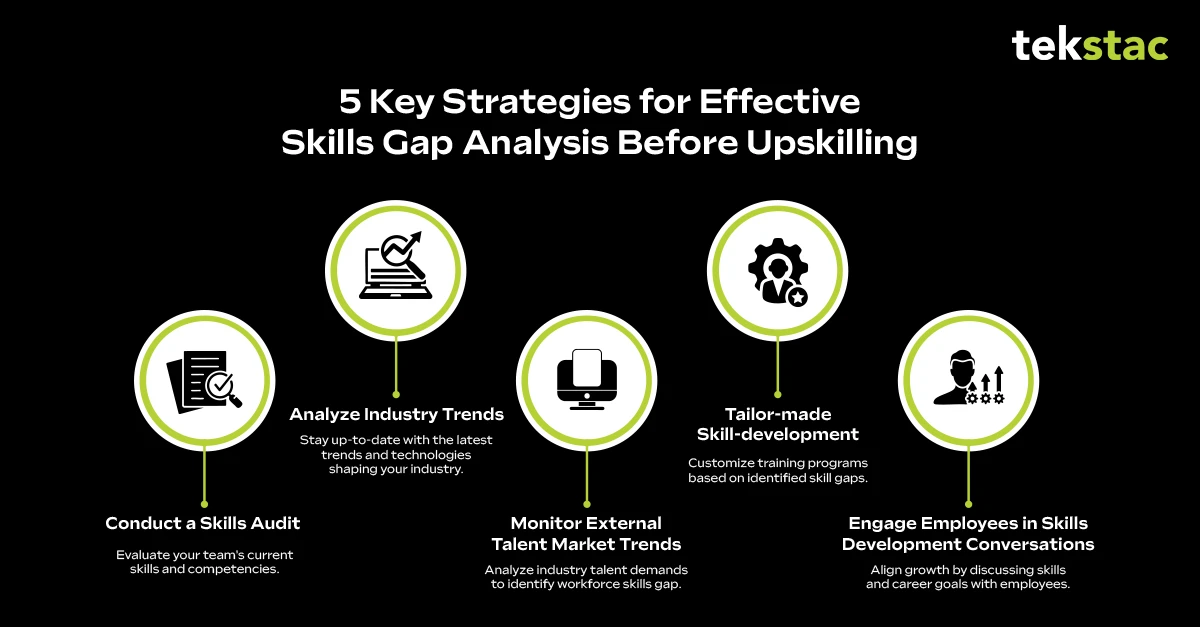
1. Conduct a skills audit
A skills audit is conducted to assess the current skill set of the workforce and determine whether it is up-to-date. It should be performed periodically to verify the capabilities of each employee and the overall skills of the team.
Consider the following points to do a skills gap analysis using a skills audit strategy.
- Study the latest trend in the market to know the in-demand skills as said earlier and review industry reports.
- Learn what skills the competitors prioritize in the job and employee development programs.
- Assess and check skills gaps regularly and employ a learning solution that allows learners to self-assess their skills and proficiency levels.
- Gather feedback from managers and employees to understand their perspective on training needs. This can be done through interviews, surveys, or group discussions.
2. Understand the current industry trends
To effectively identify skills gap, it’s crucial to stay attuned to the evolving needs of the industry. As industries rapidly embrace digital transformation, emerging technologies such as AI, machine learning, and blockchain are reshaping job roles and required skill sets. Understanding these shifts enables employers to anticipate future skills demands and align training programs accordingly.
Keeping track of industry reports, market forecasts, and competitor developments also provides valuable insights into which skills will be vital in the coming years, allowing organizations to proactively address the gaps before it becomes too late.
3. Monitor external talent market trends
By analyzing the talent pool outside your organization, you can gain a clearer understanding of the skills that are currently in demand. Reviewing job postings from competitors and industry leaders offers a valuable benchmark to compare the capabilities of your existing workforce. This comparative analysis helps highlight areas where your employees may be lacking.
Additionally, understanding the skills required by external candidates ensures that your team remains competitive and aligned with market standards. Monitoring talent marketplace platforms, recruitment reports, and industry salary surveys can provide further insights into the evolving skill demands within your industry.
4. Tailor-made skill-development
The skills audit identifies the difference between current skills and skills required for the new role. By tracking the employees’ performances with KPIs and regular assessments organizations can identify areas for improvement.
AI-powered skilling platforms offer customized skill development solutions tailored to the specific needs of each department and role. Integrating GenAI capabilities within the learning platform has made it easier to design and implement effective upskilling programs that align with individual and organizational needs.
Regular assessments and reports help design personalized training programs. This approach specifically addresses the skills required for each role because a one-size-fits-all approach cannot address the unique skill requirements of different job roles.
5. Engage employees in skills development conversations
Engaging employees in regular career development conversations is essential to identifying skills gaps that might not be evident through formal assessments alone. Many organizations now recognize the value of listening to their employees’ aspirations and career goals. These conversations provide critical insights into where employees feel they need further development.
When employees are asked about their professional growth, they often point to skill gaps that may not be visible through performance metrics. This helps to ensure that upskilling efforts are aligned with what employees actually need, which can increase engagement and motivation.
Moreover, it promotes a culture of continuous learning, as employees take ownership of their growth, and the organization can adjust its upskilling initiatives to support both individual and company-wide goals.
Conclusion
In today’s workplace, identifying skills gap and empowering your team is important to succeed. By adopting the right strategies you can build a workforce that is ready to face future challenges.
Platforms such as Tekstac help organizations perform skills gap analysis more accurately. Leveraging the tools and proactive approaches, businesses can implement effective upskilling programs that promote a continuous learning environment and ensure employees grow with the company.
Remember, upskilling is an ongoing journey.
As the skills and job roles continue to evolve, organizations must remain agile and proactive in identifying emerging trends and adapting their workforce strategies to stay ahead of the curve.
So, don’t wait any further.
Build a capable and resilient future-ready workforce with Tekstac!
Skills Gap Analysis FAQs
1. How often should skills gap analysis be done?
A skills gap analysis can be performed annually or twice a year. It should be a constant process that can be repeated.
2. Which specific areas within the IT sector are facing the biggest skills gaps in 2025?
Cybersecurity, Machine learning, Cloud Migration, and Big Data.
3. How can employers identify the knowledge and skills of employees?
Employers can track their employees’ performances through assessments. By doing periodic skills assessments and skills inferences through various methods, employers can identify individual skills gap and take appropriate measures.
Personalized Learning: The Key to Bridging the Skills Gap
Closing the Skills Gap with Personalized Learning
Due to evolution of technology and changing business requirements, the need to bridge skills gap intensifies on a daily basis. This rapid change magnifies the existing skills gap, leaving traditional, standardized training methods struggling to keep pace.
As a result, employees may find themselves left behind, unable to meet new demands despite the training they receive. If the pace of upskilling isn’t fast enough, it may not just slow individual progress but also impacts team productivity, stifles innovation, and affect overall company performance.
These limitations highlight the need for a tailored approach-one that recognizes each learner’s unique background, skill set, and preferred learning style.
Here, personalized learning emerges as a powerful solution that not only responds to the need for different learning preferences but also fills the skills gap, boosts individual improvement, and enhances team productivity.
A recent PwC survey found that 70% of CEOs believe that personalized learning contributes to greater innovation within their organizations.
The Challenge of Skills Gap in a Diverse Workforce
As industries become increasingly technology-driven, job requirements are constantly evolving, which widens the skills gap across multiple sectors.
The term “skills gap” refers to a disparity between an employee’s existing skills profile and the skills that are needed for effective performance in current or future positions. When ignored, these gaps may lead to lower productivity, limited creativity and innovation, and increased employee turnover.
These challenges are magnified within a diverse workforce. This is due to generational differences Gen Z, Millennials and Gen X, who have different dynamics of comfort with technology, learning preferences, and career goals.
Furthermore, cultural diversity creates different ways of problem-solving, communication, and teamwork styles. Therefore, a one-size-fits-all training program often falls short.
What is Personalized Learning?
Personalized learning goes beyond traditional training by adapting development programs to each employee’s specific needs, learning style, and skill level. This individualized approach allows employees to progress at their own pace, fostering deeper engagement and a stronger connection to the material.
By aligning learning objectives with individual goals, personalized learning helps employees not only acquire the knowledge they need but also apply it effectively within their roles.
Moreover, personalized learning uses technology to create adaptive, immersive experiences. AI-driven platforms offer customized learning paths, targeted assessments, and instant feedback, tailoring each employee’s journey.
This approach maximizes impact by providing content and support that meets individual needs, fostering continuous skill development. As a result, organizations gain a more agile and capable workforce prepared for evolving demands.
Core Aspects of an Effective Personalized Learning Program
Designing an impactful personalized learning program requires meticulous planning & execution. Here are some key factors to consider.
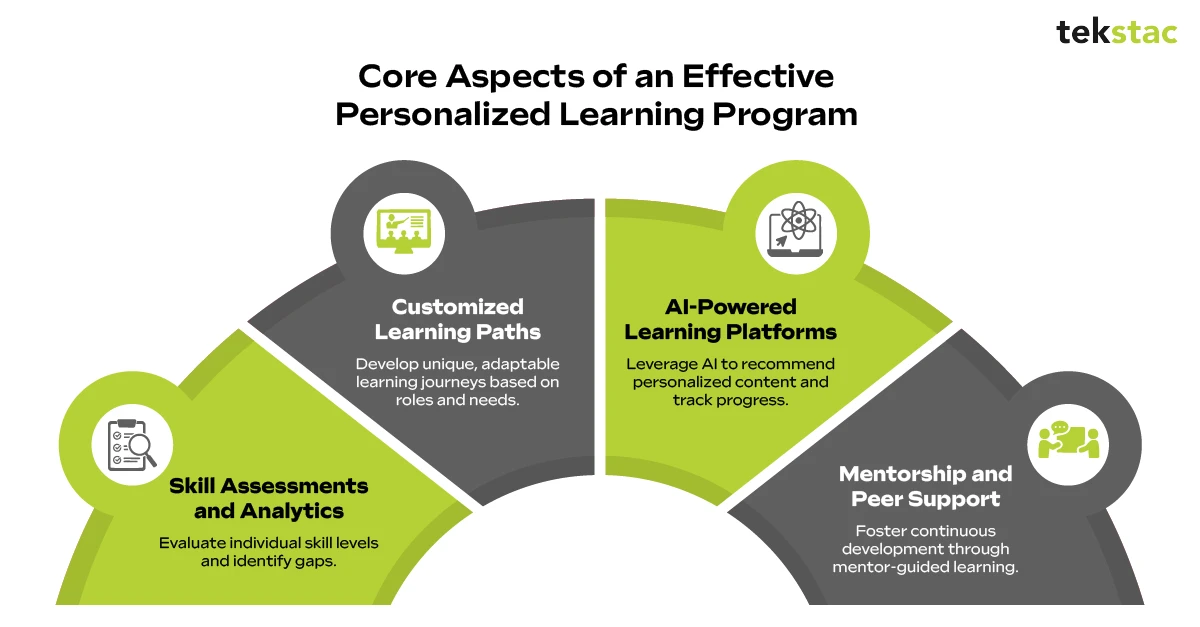
Skill Assessments and Analytics
The initial process for implementing personalized learning starts with identifying individual skill gaps. Regular evaluations and data analytics offer insights into each employee’s present skill level, thus enabling organizations to create targeted learning curves. This insight also helps senior-level managers oversee progress and refine learning agendas as necessary.
Customized Learning Paths
Some of the strategies that should be incorporated in personalizing learning include tailored paths that align with individual roles, career goals, and skill levels. These pathways can feature a combination of content types, like video guides, interactive modules, articles, and case studies to accommodate different learning styles.
AI-Powered Learning Platforms
Advanced AI technology can process data from employee evaluations and learning engagements and recommend customized content that suits each learner’s requirements. AI platforms can dynamically adjust learning paths dynamically thus providing a highly personalized experience and minimizing the need for human intervention.
Mentorship and Peer Support
Mentorship and peer support add more value to personalized learning. When employees are allowed to participate in peer-to-peer learning and build connections with mentors, it can drive knowledge sharing, cultivate a sense of community, and foster continuous improvement.
Tackling Potential Hurdles in Personalized Learning
While the advantages of the personalized learning approach cover a wide range of aspects, successfully integrating it into a diverse organization involves overcoming potential challenges.
According to Gartner, 70% of employees report not mastering the skills needed for their current jobs.
Resource Allocation
Designing a personalized learning program to suit an individual’s needs requires substantial resources. Organizations that plan to maximize ROI should initially start by focusing on essential skills gap and then gradually expand the program.
Technology Integration
Personalized learning is highly dependent on technology, such as artificial intelligence and data analytics. Incorporating these tools into an organization’s current framework demands strategic planning & investment.
Upskilling platforms like Tekstac are revolutionizing this process by providing a seamless, scalable solution for companies looking to implement personalized learning paths without the technological hurdles.
Tekstac’s platform uses advanced AI to create customized learning journeys for employees, aligning content with their skill levels, career aspirations, and specific job requirements. This integration simplifies the deployment of personalized learning, ensuring that technology becomes an enabler rather than a barrier.
Employee Buy-In
Personalized learning programs are effective only if employees completely engage with them. Organizations need to highlight these programs’ advantages and help employees understand how personalized learning can advance their career growth.
Benefits of Personalized Learning in Reducing Skills Gap
1. Improved Engagement and Motivation
Employees are more likely to participate in learning programs that resonate with their personal interests and career aspirations. Personalized learning enhances motivation by offering learning that aligns with an employee’s position, growth potential, and challenges.
A study by LinkedIn Learning revealed that 94% of employees would prefer to remain with a company that actively invests in career advancement, thus underscoring the critical role of immersive, tailored learning experiences in retaining talent.
2. Accelerated Skill Acquisition
Personalized learning allows employees to concentrate on specific skills related to their current job role, thus helping them learn new competencies more effectively. By utilizing AI-driven platforms and data-based assessments, personalized learning programs can detect and target each individual’s skills gap, thus refining the learning process.
For instance, if an employee wants to enhance their digital proficiency for a new position, a customized program can skip unnecessary learning content and focus on high-priority topics relevant to their responsibilities.
Based on a report by Deloitte, organizations using personalized learning are 58% more likely to report that their workforce’s skills align with business goals.
3. Flexible Learning Pathways
Allowing employees to advance at their own pace, personalized learning provides a refreshing alternative to traditional, rigid training programs. This flexibility is particularly helpful in a multifaceted team where each individual has different levels of experience or prior knowledge in specific areas.
Dynamic learning platforms can track an employee’s learning pace and modify content as needed to ensure that each learner grasps the required skills without feeling hurried or left behind. This approach prevents the learner from getting frustrated and sustains the learner’s confidence.
4. Targeted Feedback
Regular evaluations and feedback cycles allow employees to monitor their progress and recognize areas for improvement. Continuous feedback helps employees rectify mistakes and strengthen their abilities, thus fostering ongoing skill enhancement.
For instance, an employee who is learning a new programming language can get immediate feedback in real-time on their coding exercises, thus allowing them to consistently hone their skills rather than waiting for formal reviews.
According to the National Training Laboratory report, personalized, adaptive learning methods lead to 60% higher retention rates compared to traditional lecture-based training.
5. Enhanced Collaboration
Within a diversified workforce, employees contribute unique strengths & viewpoints. Personalized learning platforms offer peer-to-peer learning, motivating knowledge exchange across generations and cultural backgrounds.
Through discussion boards, collaborative projects, or mentorship programs, employees can benefit from each other’s experience and expand their skill sets. This approach helps close skills gap by leveraging the shared knowledge & expertise within the organization.
Final Thoughts!
Next-Gen Workforce Development with Personalized Learning
A study by McKinsey revealed companies that invest in personalized learning report a 20-25% increase in productivity.
Personalized learning goes beyond a mere trend; it is a proactive approach that addresses the needs of a diverse and rapidly evolving workforce. From boosting employee engagement and retention to improving productivity, the advantages of personalized learning are evident.
According to a study by Training Industry, employees in personalized learning programs reach competency 34% faster than those in traditional training programs.
As businesses invest in such programs, they become ready to embrace future challenges, building an environment where each employee is equipped with the right tools & support to succeed.



